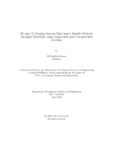| dc.contributor.advisor | Alam, Md. Golam Robiul | |
| dc.contributor.author | Ahasan, Md Rakibul | |
| dc.date.accessioned | 2022-09-05T06:54:04Z | |
| dc.date.available | 2022-09-05T06:54:04Z | |
| dc.date.copyright | 2022 | |
| dc.date.issued | 2022-04 | |
| dc.identifier.other | ID 20166055 | |
| dc.identifier.uri | http://hdl.handle.net/10361/17164 | |
| dc.description | This thesis is submitted in partial fulfillment of the requirements for the degree of Master of Science in Computer Science and Engineering, 2022. | en_US |
| dc.description | Cataloged from PDF version of thesis. | |
| dc.description | Includes bibliographical references (pages 40-42). | |
| dc.description.abstract | In a mobile network, there are a lot of data that can provide network detail about
network efficiency, robustness, and availability. A type of data is mobile network
performance data obtained from the key performance indicators (KPI) or the key
quality indicators (KQI). An integral part of mobile network monitoring is it monitor
any unusual pattern in the performance data. The pattern detection or anomaly
detection use case from performance data is essential for mobile operators because it
detects issues in the network that are not possible to detect by the network alarms.
A machine learning-based anomaly detection model is most common nowadays.
This thesis demonstrates a supervised and unsupervised machine learning-based
anomaly detection model. The base data set is paging success rate performance
data of day-level and hourly-level granularity. Secondly, a comparative analysis is
present over various anomaly detection models. Thirdly, the data used in this paper
has an imbalance scenario and how the re-sampling technique can affect the
outcome of the anomaly detection model. Lastly, one supervised machine learning
recommends mobile network anomaly detection. However, implementing supervised
machine learning over a large data set is more computational because it requires
ground truth determination. On the other hand, unsupervised machine learning
will cluster various data volumes without any prerequisite. If proper tuning is in
place on this model, it will give an efficient anomaly detection. Another aspect of
this thesis is to identify unsupervised machine learning that is best suited for mobile
network anomaly detection. To do that a benchmarking approach is performed
over three unsupervised machine learning, and these are K-means, DBSCAN, and
HDBSCAN. The thumb rule of the benchmark follows as converting the unsupervised
machine learning output into a classification problem and then measuring the
model performance. The deep learning implication of anomaly detection in 4G network
performance data exercise in this thesis and an autoencoder used to see how
it performs in anomaly detection with moderate accuracy. | en_US |
| dc.description.statementofresponsibility | Md Rakibul Ahasan | |
| dc.format.extent | 42 pages | |
| dc.language.iso | en | en_US |
| dc.publisher | Brac University | en_US |
| dc.rights | Brac University theses are protected by copyright. They may be viewed from this source for any purpose, but reproduction or distribution in any format is prohibited without written permission. | |
| dc.subject | Anomaly detection | en_US |
| dc.subject | Supervised learning | en_US |
| dc.subject | KPI | en_US |
| dc.subject | Mobile Networks | en_US |
| dc.subject | SMOTE | en_US |
| dc.subject | Unsupervised learning | en_US |
| dc.subject | K-Means | en_US |
| dc.subject | DBSCAN | en_US |
| dc.subject | HDBSCAN | en_US |
| dc.subject | Autoencoder | en_US |
| dc.subject.lcsh | Algorithms | |
| dc.subject.lcsh | Computer network architectures | |
| dc.title | 3G and 4G paging success rate based mobile network anomaly detection using supervised and unsupervised learning | en_US |
| dc.type | Thesis | en_US |
| dc.contributor.department | Department of Computer Science and Engineering, Brac University | |
| dc.description.degree | M. Computer Science and Engineering | |

